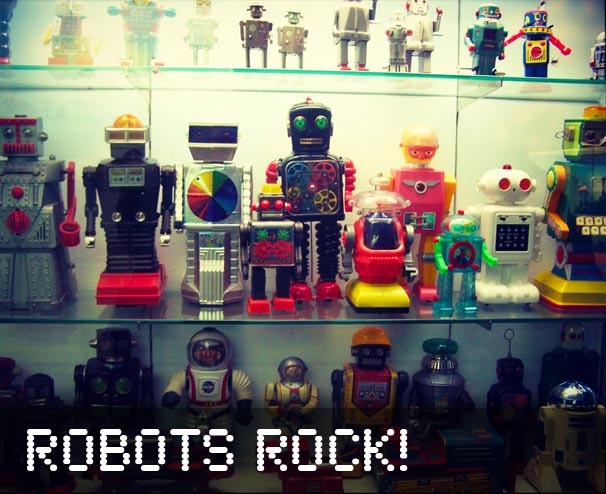10 robots that most influenced history

It would be wrong if GeekTech would not have written anything for the Robotics Week , and if there is a thing that this blog loves, then these are robots. Robots are constantly around us, from the coffee maker in the kitchen to the assembly lines at work. But where did the first robots come from? Who were the founders of the robots we see now?
There are hundreds of incredible robots, but we have selected some of the most significant and memorable in chronological order.
')
Around 350 BC: The Pigeon
This first "robot" is really very old. Archit, Greek philosopher, astronomer, mathematician and statesman, outlined the principles of mechanics. One of his projects was a wooden mechanical bird. It was set in motion by the ferry and could fly up to a height of 200 meters. This invention may not just be the first robot on the planet, but also the first flying device.
1495: Leonardo's Robot

Leonardo da Vinci also participated in the history of robots. He designed the first humanoid robot. In 1495 he created a robot knight who, judging by the sketches, could stand, sit, raise his visor and move his arms.
Using original sketches, modern designers managed to recreate the robot. A copy can perform all of the above movements.
1738: The Duck

The French inventor Jacques de Vaucanson at one time created several autonomous robots, but The Duck is one of his most outstanding works.
Mechanical duck had more than 400 different parts, which is not too surprising, considering what she could do. A duck could flap its wings, eat, digest food, and then defecate. It was quite an impressive robot!
Vaucanson managed to “teach” the robot to digest food, thanks to the installation of compartments for chemical decomposition of grain.
Only now, after 274 years, modern robots appeared with similar capabilities, for example, Ecobot , although he only knows how to digest, unlike the duck, which could perform other fun “tasks”.
Unfortunately, no one knows what happened to the original duck. However, the museum in Grenoble has a copy of a duck, created by a watchmaker.
1898: Tesla's Remote-Controlled Boat
Perhaps you know Nikola Tesla because of his electric coils, but he has another achievement in the field of robots.
When Nicola was looking for a way to demonstrate his wireless transmission system (what we now know as radio waves), during the conference he put the iron boat into the water at Madison Square Garden and controlled it using the remote control, the boat received the signals and executed the commands of Nikola. At that time, no one understood how a remote control boat would affect the future of robots, toys, radios and other devices that we use now.
1962: The Unimate
In the 60s of the 20th century, inventors put a lot of effort into the development of robotic arms, but one of the most important inventions was The Unimate arm. It was one of the first industrial robots installed on the General Motors assembly line to reduce the likelihood of injury and death at work. The device could fold parts of hot cast metal and weld parts of the body. Unimate is currently in the Hall of Fame with robots such as R2-D2 and HAL.
1966: Shakey the Robot

Shakey the Robot was one of the first truly successful robots with artificial intelligence. He could understand his own actions. If you were to give Shakey a task, he would analyze it, unlike other robots who needed certain instructions.
Shakey demonstrated his ability to think and react by moving around the rooms and corridors, turning the lights on and off, opening and closing doors, moving objects. Currently, the robot is retired and is located in a museum in Mountain View.
1989: Genghis
Have you ever wondered which robot was one of the first to learn to walk? This is Genghis. This six-legged autonomous robot, created by the Mobile Robots Group in the laboratories of the Massachusetts Institute of Technology, was not only renowned for its ability to walk, but also for how quickly and cheaply it was produced. However, it needs 4 microprocessors, 22 sensors and 12 servomotors to function.
His walk was called "the Genghis Gait". The first steps of the robot:
1997: NASA Mars Pathfinder and Sojourner

NASA also contributed to the development of incredible robots, but the robot that really stands out is Mars Pathfinder and Sojourner.
Its main goal was to demonstrate the technologies necessary for effectively and economically acceptable sending a robot to Mars. The robot managed to enter the atmosphere of Mars and send a lot of useful data about the Red Planet to Earth for further study.
1998: Lego Mindstorms
There would be no GeekTech without mentioning LEGO. The Mindstorms series, containing programmable hardware and software, was one of the cheapest and easiest ways for those who wanted to make their own robot. The creation of this series was inspired by Seymour Papert's The Storm of the Mind: Children, Computers, and Fruitful Ideas, in which the mathematician proposed a simple theory of learning by doing.
2000: ASIMO

Back in 1986, Honda announced its intention to take part in a project to create a humanoid robot that can not only exist with people, but also exceed their capabilities. A little later, Honda announced ASIMO, one of the most impressive robots. He can emulate the gait of a person, use his hands, speak and listen, see and recognize people and objects. Of course, ASIMO has something to strive for before it can surpass human abilities, but Honda already has a lot of ideas for the future development of this robot.
Source: https://habr.com/ru/post/142083/
All Articles